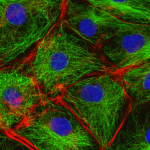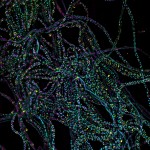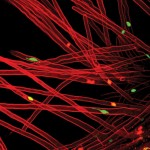You’re both wonderful and amazing! You’re wonderful because you are just you, unique in so many ways. You’re amazing because (according to recent estimates) you are made up of about 37 trillion (3.7 x 1013) cells of some 200 different types. You have 50 billion fat cells, 2 billion heart cells and whopping 240 bilion liver cells. Most of your cells have features in common with cells in animals and plants the world over from a great white whale to a tiny moss plant. When you next watch a wildlife film spend a few seconds visualising all the plants and animals as cells. You will ‘see’ trillions of them.
You are also amazing because within each of your cells, working every nanosecond of your life from when you were conceived is a highly structured organisation.
Welcome to the city of the cell! In this city there are fibres along which minute molecular motors transport products, moving them as if they were on a rack and pinion mountain railway. Here too, in different parts of the city of the cell, are energy converters called mitochondria. They turn energy from food into the type of chemical and electrical energy required by a cell. In a muscle cell the energy is required to make it contract and operate.
-

This image shows some animal cells. They are stained with fluorescent labels to help visualise the cytoskeleton with microtubules (green), actin filaments (red), and the nucleus (blue).
The cytoskeleton is not usually shown in simple diagrams of the cell because it is a complex meshwork of strands. Cells would not be cells with out their cytoskeleton (Images courtesy of Mark Shipman, James Blyth and Louise Cramer, Laboratory for Molecular Cell Biology, University College London, UK)
-

In filamentous cells of the bacterium Rhodobacter sphaeroides, the tubulin homolog FtsZ (tagged with CFP) forms dot-like and spiral structures in two distinct populations. The FtsZ cytoskeleton affects the localization of the membrane chemosensory protein clusters (YFP). Cell bodies are shown in magenta.
Image Courtesy of Sheng-Wen Chiu, Department of Biochemistry, University of Oxford
-

Arabidopsis root hairs
Image Courtesy of Dr. Juliet Coates
In this city of the cell there is a need for communication and we find chemical and electrical messages darting around saying “do this”, “stop that reaction” and in one fantastic process called programmed cell death, the cell instructs itself to shut down and demolish itself disposing safely of all the debris. This happens throughout life but this essential process is noticeable when a tadpole ‘losses’ its tail during metamorphosis. In the same way we lose the webbing between our fingers and toes as we develop before birth.
Somewhere in the city, probably near the centre, is the City Head Office. In your cells this is called the nucleus and it is where all the construction plans and operating instructions are kept in code form. Nearly all your cells have a nucleus and the coded information is contained in a molecule called DNA.
The cell is the basic functional unit of life. Although there is probably no such thing as a typical cell, cells from different higher animals and plants have many internal structures and chemical reactions in common. Cells of the same age and type from a whale, a mouse or a fruit fly would all be very similar to yours.
Cell biology is an exploration and study of life at the level of the cell, the parts that make up the cell and how those parts function at the molecular level.
It is also the study of how cells interact with one another, how the normal growth of cells is controlled, how they divide, and pass on their genetic information and how they die. It is the study of how cells move, obtain, release and use energy and communicate and signal to one another. Cell biology is biology at the centre of life and the critical centre of your life is you.
Welcome to cell biology!
SOMETHING TO THINK ABOUT:
You are doing some research work on cells from a mouse to help understand the cell biology of an endangered species of whale – how could you explain why you are using mouse cells to someone who thinks only of a whale as an enormous animal living in the sea and a mouse as a tiny land mammal that can be a pest?